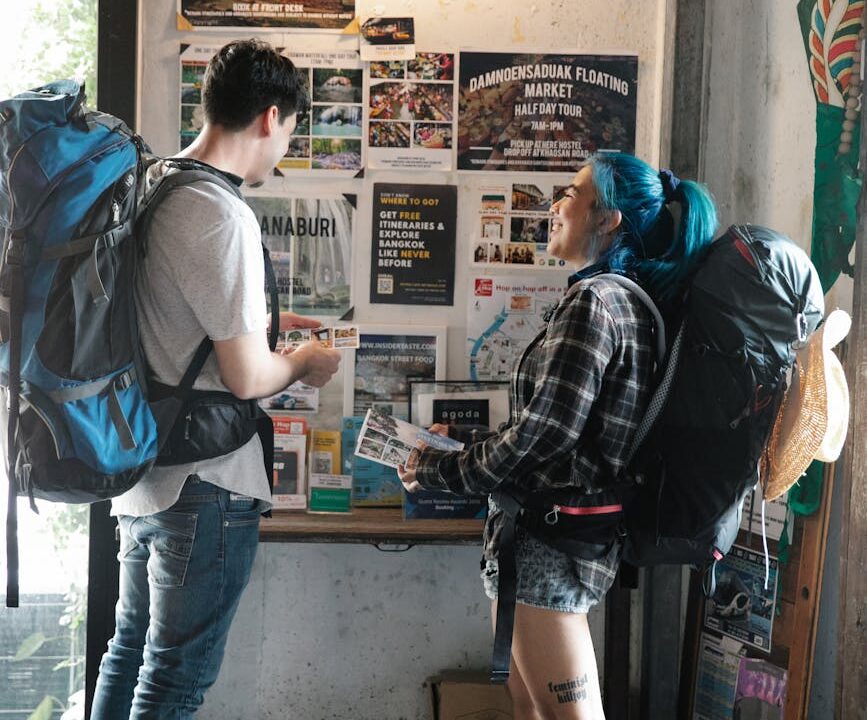
Outdoor Adventure Essentials
Getting ready for a backpacking trip? Nailing down the essentials makes any trip safer and more fun. Let’s dive into the must-haves.
Gear and Equipment Checklist
The right gear is key to enjoying your backpacking adventure. Here’s a list of what’s necessary and how to choose smartly.
Gear Checklist
- Backpack: A comfy and sturdy backpack that’s spacious enough for everything.
- Tent: Lightweight, easy to set up, and can handle the weather.
- Sleeping Bag: Keeps you cozy at night, suited for the chill ahead.
- Sleeping Pad: Helps with warmth and adds a touch of comfort.
- Stove and Fuel: A small but trusty stove with enough fuel for your whole trip.
- Cookware: Lightweight pots, pans, and utensils—basic, but get the job done.
- Food and Water: Non-perishable snacks and a water filter you can count on.
- Clothing: Wear layers for changing weather; don’t forget rain gear (National Park Service).
- Navigation Tools: Map, compass, and a GPS gadget.
- First Aid Kit: Loaded kit with essentials like moleskin and bug spray.
- Emergency Communication Device: Think Personal Locator Beacon or Satellite Messenger (An Ordinary Existence).
Equipment Selection Tips
- Experience Level: Gear up according to how much experience you have (National Park Service).
- Carrying Capacity: Don’t overload, just pack what you can lug around comfortably.
- Physical Fitness: Match your gear with your fitness level and how challenging your hike is.
- Environmental Familiarity: Choose stuff that’s good for where you’ll be trekking.
Emergency Preparedness Plan
Being prepared for emergencies isn’t just smart—it’s necessary. Here’s what to include in your wilderness plan.
Key Components of an Emergency Plan
- Basic Wilderness First Aid Knowledge: Skills like CPR and basic first aid are handy.
- Communication Plan: Tell someone your plans and when you expect to be back.
- Emergency Kit: Have items like a whistle, signal mirror, and a multi-tool.
- Shelter: An extra emergency shelter, maybe a bivy sack or space blanket.
- Navigation Tools: Bring both electronic and manual navigation tools.
- Food and Water: Have extra just in case things don’t go as planned.
- Fire Starting Kit: Waterproof matches, lighters, plus a few fire starters.
- Personal Locator Beacon/Satellite Messenger: Perfect for sending SOS signals.
| Essential Item | What It’s For | Example |
|---|---|---|
| Emergency Communication Device | Sends an SOS signal with your location | Personal Locator Beacon |
| First Aid Kit | Packed with basic first aid gear | Adventure Medical Kits Comprehensive |
| Fire Starting Kit | Starts a fire, rain or shine | UCO Stormproof Match Kit |
These steps make you ready for surprises (National Park Service).
If you’re itching for more hiking tips or ideas about gadgets, peek at our pieces on mindfulness tips and best gadgets.
Backpacking Basics
Thinking about hitting the trails? Backpacking is like freedom on two feet. To keep things fun and safe, let’s get down to the nitty-gritty of trip planning, safety, and keeping your bearings.
Trip Planning Tips
Plan smart, adventure hard. Here’s what really matters before you hit the trail:
- Assess Your Experience Level: Pick a trek that suits your stamina. Know your limits when it comes to rough pathways and long hikes.
- Research the Route and Terrain: Scope out your path. Check those ups and downs, if there are any tricky spots, and where to find good ol’ H2O.
- Check Equipment: Is your gear up to snuff for the trip? Weather changes everything, but a busted tent or a leaky water bottle might ruin more than just your mood.
- Pack Smart: It’s a balancing act—carry what you need but keep it light. Don’t forget a map, compass, first aid kit, multi-tool, plus munchies and water.
For more on what’s essential, see our gear and equipment checklist.
Hiking Safety Measures
Safety first, fun second—even when backpacking. Here’s how to play it safe:
- Stay Informed: Find out what critters you’ll meet and what’s the weather’s saying. Know the dangers before you go wandering in Mother Nature’s backyard.
- Emergency Plan: Know your “uh-oh” plan by heart, and don’t skimp on those CPR and first aid skills.
- Travel with a Friend: Got a hiking buddy? Great! If you’re solo, be sure a pal knows all your deets and your likely home time.
- Stay on Marked Trails: No joyrides here. Venturing off-trail can mean everything from oopsies to oye vey. Stick to them like glue.
For more help on prepping for “Oh no!” moments, swing by our exclusive deals test.
Wilderness Navigation Skills
Get lost when you’re trying to, not when you really need a bathroom. These tips will help you stay en route:
- Use a Map and Compass: Don’t just pose with them, know how they work. They are lifesavers in those no-bar land areas.
- GPS and Digital Maps: Tech it up with GPS or phone apps. Keep them juiced up—unplugged gadgets can make things tough.
- Landmark Recognition: Rewind to your Boy or Girl Scout days: learn those landmarks like rivers and rock shapes. They’ll keep you on track.
- Practice: Try out your navigation skills near home before you test them in the boonies.
More details on staying safe while hiking can be found in our guide hiking safety measures.
By mastering these basics, you’re not just a backpacker; you’re a trooper of the trails. For extra advice on how to keep those footpaths pristine, dive into our piece on Leave No Trace Principles.
Personal Well-being in the Wilderness
Feeling good in the great outdoors is all about keeping yourself in tip-top shape, both inside and out. Let’s get into the nitty-gritty of staying fit, clean, and mentally sharp, so your backpacking trip is everything you want it to be.
Physical Fitness Preparations
Before you hit those trails, it’s smart to get your body ready. Mixing up some cardio, strength, and stretching will keep you on your feet and loving the journey.
Weekly Sweat Plan:
| Type of Exercise | Weekly Mix | Time Each Go |
|---|---|---|
| Heart-Pumpers (walks, runs) | 3 – 4 times | Half an hour to an hour |
| Muscle Builders (squats, lunges) | 2 – 3 times | 30 to 45 min |
| Bendy Stuff (yoga, stretch) | 2 – 3 times | 15 to 30 min |
A bit of stretching during breaks and a solid loosen-up session at the end of each day does wonders for your muscles. Tweaking your backpack straps helps ease the load and keep you comfy.
Hygiene Practices
Staying fresh and clean out there isn’t just about feeling good—it’s about keeping healthy. Here’s how:
- Keep Hands Clean: Use eco-friendly soap and water.
- Teeth Stuff: Travel toothpaste makes your smile camp-ready.
- Sponge and Wipes: Wet wipes or a quick sponge bath work wonders.
- Take Your Trash: Leave no trace, and handle the bathroom business right.
Also, make sure you’re not inadvertently inviting the critters by using bug spray and putting your food up and away.
Mental Preparedness Techniques
Your mind needs some prep too—getting your head in the game is half the journey. Here’s how to keep that noggin’ positive:
- See It: Picture yourself nailing the hike.
- Stay Now: Keep your mind here and now, with some mindfulness exercises.
- Write It Down: Keeping a journal of your trek stories and thoughts can be therapeutic.
- Handle It: Be ready for any squabbles out there—stay cool and handle them.
Get some first aid know-how under your belt, like Wilderness First Aid and CPR, to be ready for anything. For trip planning that covers all bases, check out our travel essentials and adventure tips guides—it’s like a one-stop-shop for your wild journey needs.
Environmental Awareness and Impact
Heading outdoors for some fresh air? It’s important to keep in mind how our adventures affect the planet. Here, we’ll chat about some simple but powerful ways to keep our beautiful surroundings intact for those who come after us.
Sustainable Practices
Sustainable habits can truly make a difference when we hit the trails. Let’s dive into a few easy-to-follow actions to help Mother Nature.
-
Cut Down on Waste: Opt for stuff you can use again and again, like a trusty water bottle or sturdy utensils. Chuck the single-use plastics – they belong in the past.
-
Gear That Cares: Invest in equipment that’s gentle on the earth. Look out for labels like Fair Trade or products made from organic materials.
-
Think Local, Eat Local: Pick foods that haven’t traveled across the globe to get to you. Local and in-season eats are the way to go.
-
Smart Gadgets: Use devices that won’t have you burning through batteries as if they’re confetti.
Sustainable Gear Features
| Item | Eco-friendly Option | Certification |
|---|---|---|
| Water Bottle | Reusable Stainless Steel | BPA-free |
| Utensils | Bamboo or Metal | Fair Trade |
| Containers | Silicone or Glass | BPA-free |
| Sleeping Bag | Recycled Materials | Global Recycled Standard (GRS) |
Curious about more ways to green up your travels? Check out our travel essentials test.
Leave No Trace Principles
Keeping our outdoor spaces pristine isn’t just nice; it’s crucial. Follow these guidelines to be a responsible nature lover.
-
Plan and Prep: Know the lay of the land and any dos or don’ts before you hit a trail. (Wilderness and Waves)
-
Stick to the Path: Keep to the marked trails and camp spots. No need to go all Bear Grylls and bushwack through untouched nature.
-
Tidy Up: Whatever you bring in, bring it out with you. Go for that “Leave only footprints” vibe. (National Park Service)
-
Let It Be: Admire the plants, rocks, and historical finds, but leave them where they belong.
-
Campfire Etiquette: When fires are allowed, use existing fire rings and go easy on the firewood. A camp stove does the trick too.
-
Wildlife Watching 101: Look but don’t touch – or feed. And stash your snacks somewhere critters can’t get to them. (Wilderness and Waves)
-
Share the Serenity: Keep the noise down and give a friendly nod to fellow adventurers passing by.
Leave No Trace Checklist
| Principle | Action |
|---|---|
| Plan Ahead | Research Destination |
| Durable Surfaces | Use Trails, Camp on Hard Ground |
| Dispose Waste | Pack Out Trash |
| Leave Natural | Do Not Disturb Environment |
| Minimal Fires | Use Established Rings |
| Wildlife Respect | Do Not Feed Animals |
| Respect Visitors | Keep Noise Down |
By being kind to the earth and sticking to these principles, we’re doing our part to keep nature stunning and welcoming. For more nifty tips on responsible exploring, have a look at our building habits test and test mindfulness tips.
















